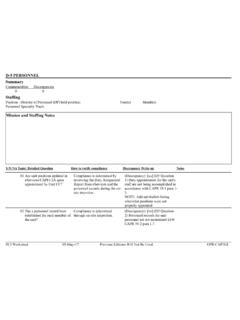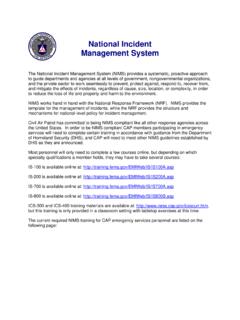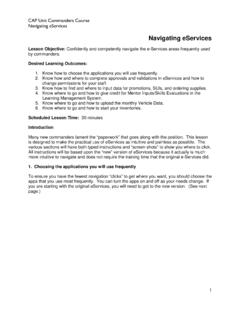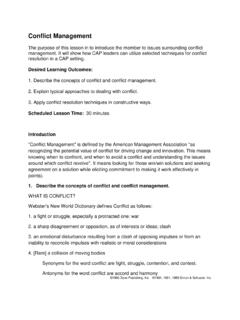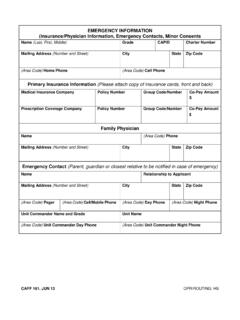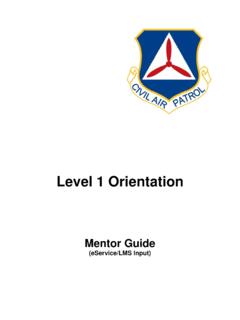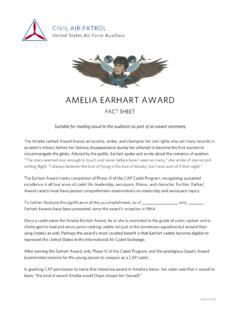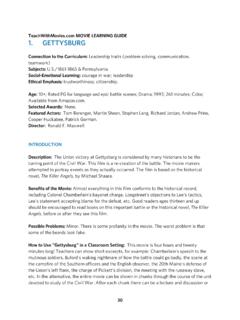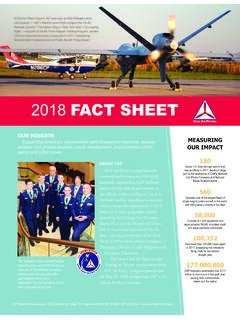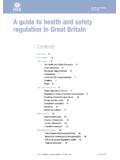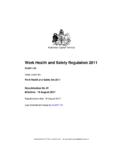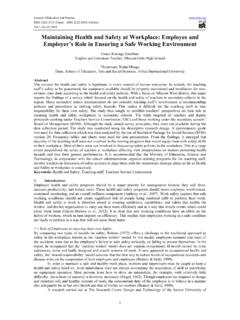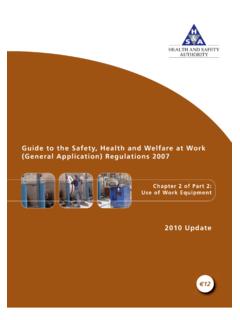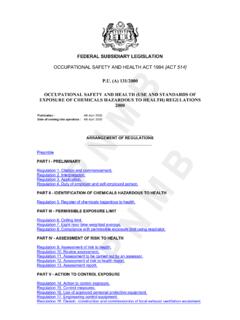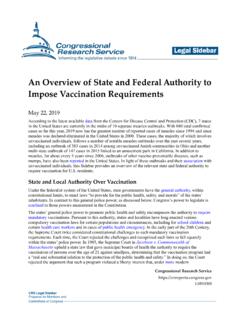Transcription of CAP REGULATION 160 -1 - Civil Air Patrol
1 NATIONAL HEADQUARTERS Civil AIR Patrol CAP REGULATION 160-1 1 NOVEMBER 2019 safety Civil AIR Patrol safety PROGRAM Supersedes: CAPR 62-1, 19 December 2012 OPR: SE Distribution: Pages: 33 This REGULATION prescribes the Civil Air Patrol (CAP) safety Risk Management (RM) Program. Commanders are responsible for compliance with the procedures outlined in this REGULATION . This REGULATION is applicable to all CAP members. As appended by other regulations , operating instructions and pamphlets, it is the National Commander s intent that the language, structure and philosophies of the safety Management System (SMS) and the practice of RM outlined herein apply to all.
2 SUMMARY OF CHANGES. This document replaces CAPR 62-1 , Civil Air Patrol safety Responsibilities and Procedures. It is an entirely new publication and should be reviewed in its entirety. All references to Operational Risk Management (ORM) have been removed and replaced with the term Risk Management (RM) to emphasize the importance of the RM process in all aspects of CAP, not just in Operations. Table of Contents .. Page Chapter 1 - Program Overview .. 3 Purpose .. 3 safety Vision .. 3 safety Management System .. 4 Figure safety Management System .. 4 safety Management System Pillars.
3 4 Figure Risk Management .. 5 safety Culture .. 6 Chapter 2 - Roles and Responsibilities .. 8 Operating Instructions, Pamphlets, Supplements to this REGULATION .. 8 Waivers.. 8 Leadership Responsibilities .. 8 Command Responsibilities .. 8 Member 10 safety Staffing .. 10 Chapter 3 - safety Risk Management .. 16 safety Risk Figure Risk Management Steps .. 16 Risk Management Principles .. 16 Required Levels of Risk Management .. 16 Acceptance of Risk.. 18 CORRECTED COPY2 CAPR 160-1 30 September 2019 Communication/Briefings.. 18 Personal Protective Equipment (PPE) .. 18 Hot and Cold Weather Procedures.
4 19 Chapter 4 - safety Assurance .. 20 safety Assurance .. 20 Continuous Improvement and Plan, Do, Check, Adjust (PDCA) .. 20 Measures of Effectiveness (MOE) .. 20 Mishap and Hazard Reporting and Review .. 20 safety Program Assistance to Subordinate Units .. 21 safety Surveys .. 22 Command Emphasis Items .. 22 Annual SMS Program Review .. 22 Chapter 5 - safety Promotion and Recognition .. 23 safety Promotion .. 23 Competency .. 23 safety Recognition .. 25 safety Communication .. 28 Figure safety Patch .. 29 Attachment 1 - Compliance Elements .. 30 Attachment 2 - safety Apparel.
5 32 CAPR 160-1 30 September 2019 3 Chapter 1 - Program Overview Purpose. The purpose of the CAP safety Program is to protect CAP members from death and injury while minimizing loss and damage to property. CAP s mishap prevention efforts will be organized around a vibrant safety Management System (SMS). This REGULATION outlines the CAP SMS approach to safety and risk management (RM), patterned after and adapted from the Air Force SMS and other industry best practices. This chapter outlines the philosophy behind the CAP SMS and the components of the SMS. A thorough understanding of the purpose, components, and processes outlined in this REGULATION is vital to the success of the CAP safety Program and vision.
6 Refer to subsequent chapters of this REGULATION for specific guidance on the implementation of the CAP SMS. safety Vision. The vision of the CAP safety Program is to be a recognized national leader in safety RM, committed to proactive mishap prevention and protection of our members as they pursue their missions for the United States Air Force (USAF) and their communities, and participate in all CAP activities. Accordingly, CAP is committed to the following: Risk Management. Recognizing that there is always an element of risk in our missions, activities and daily lives, RM is an on-going process used in the planning and execution of all CAP missions and activities, in groups and as individuals.
7 Continuous Improvement. As new programs and missions emerge, and existing missions and activities change, CAP is committed to the management of those changes through on-going risk assessments and the development of controls to mitigate those risks. Included in this effort is the on-going assessment of the effectiveness of existing risk controls. Education and Training. The CAP safety Program will provide members with education and training on the theory and practice of RM so that every member possesses the competence and confidence to employ RM in every pursuit. To the maximum extent possible training is standardized at a national level then tailored to local activity and mission needs.
8 The intent is to enable decentralized and personal use of standardized RM practices regardless of the nature of the event or the personnel involved. Core Competency. The goal of the CAP safety Program is for each and every member of Civil Air Patrol , as well as the organization itself, to embrace and practice RM as a core competency of Civil Air Patrol . NOTE: Chapter 1 provides an informative overview of the CAP safety Program and CAP safety Management System. Members are encouraged to read Chapter 1 to better understand the purpose, vision and structure of the CAP safety Program, realizing there are no specific compliance elements in Chapter 1.
9 Regulatory requirements begin in Chapter 2. 4 CAPR 160-1 30 September 2019 safety Management System (SMS). The CAP SMS approach to safety reflects an organizational commitment to use RM in the development, planning, execution, and assessment of all CAP missions and activities. All mishap prevention and safety initiatives at the national, region, wing, group, squadron, and flight levels should be in the context of, or in support of, one or more of the four pillars of the CAP SMS, as depicted in Figure Requirements for the implementation of the four pillars are outlined in detail in chapters 2 through 5 of this REGULATION .
10 safety Management System Pillars. The CAP SMS uses four pillars as the structure for its mishap prevention program as listed below. Pillar 1 - Roles and Responsibilities. Every member of CAP will have defined roles in support of and implementation of the CAP SMS. Active leadership commitment to the CAP SMS and personal involvement in the execution of the CAP SMS at every level of command is vital to the success of the CAP safety Program. Commanders must set the example by open and visible commitment to the SMS and are responsible for ensuring that every CAP member is aware of their roles and responsibilities in the CAP SMS.
